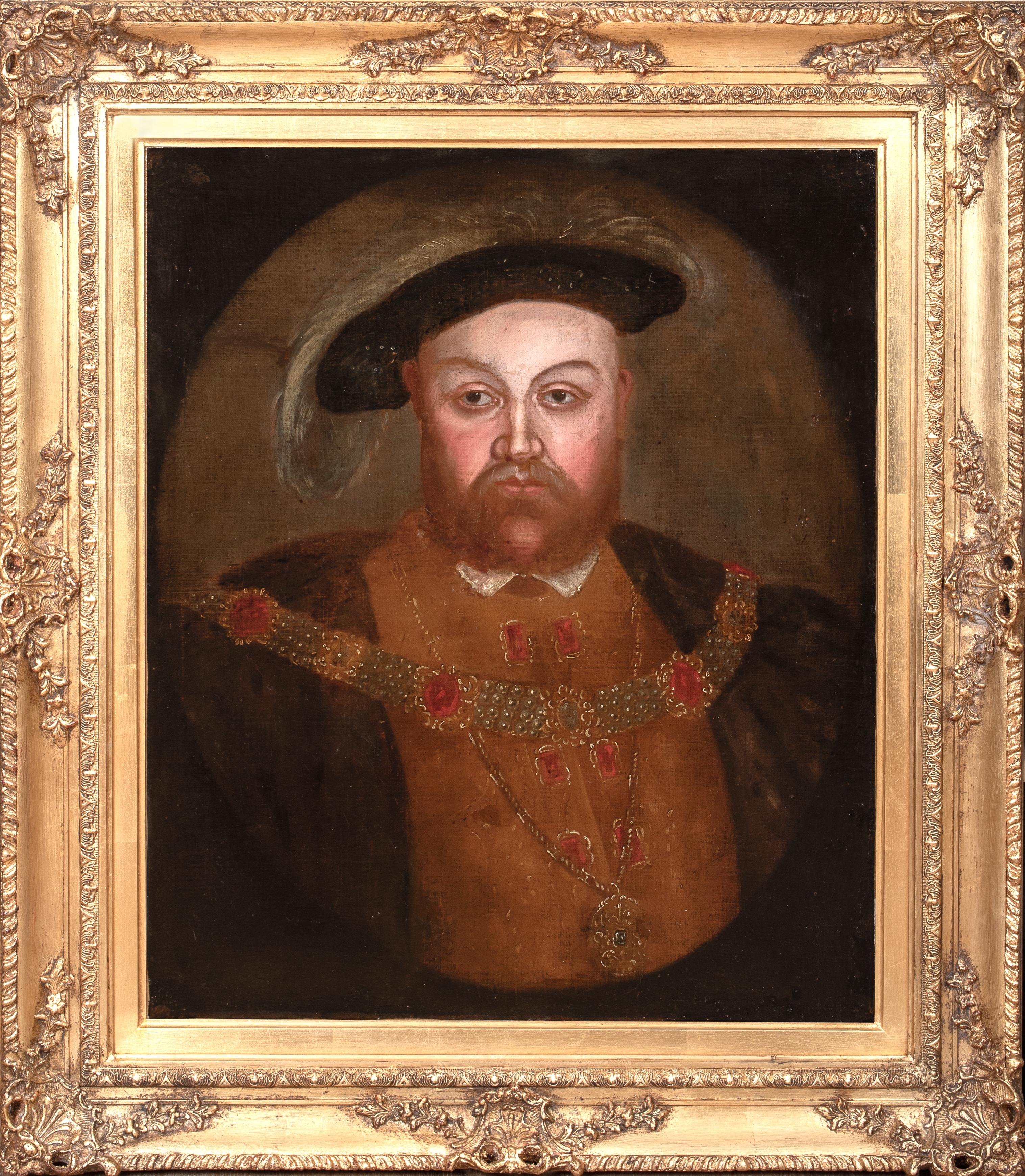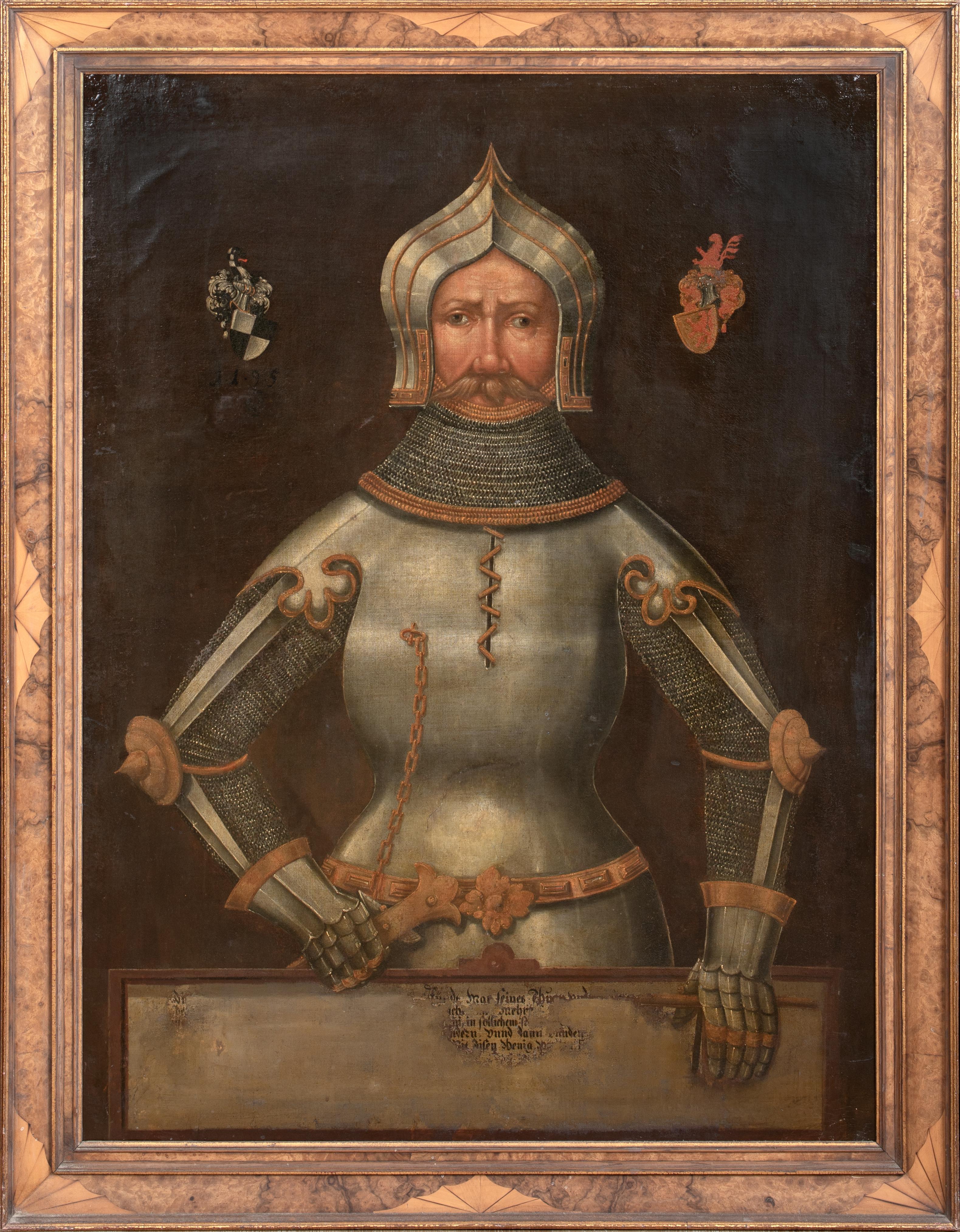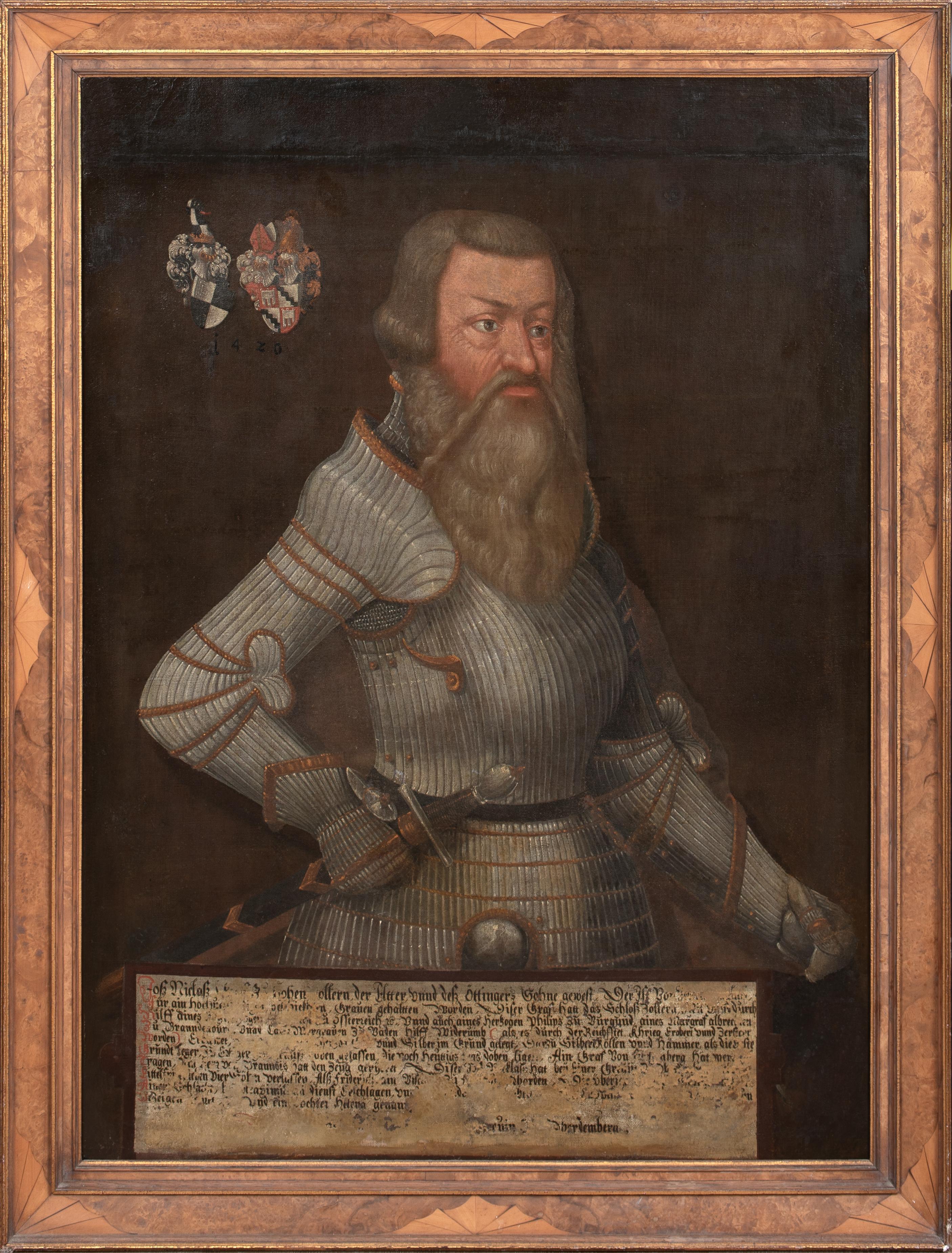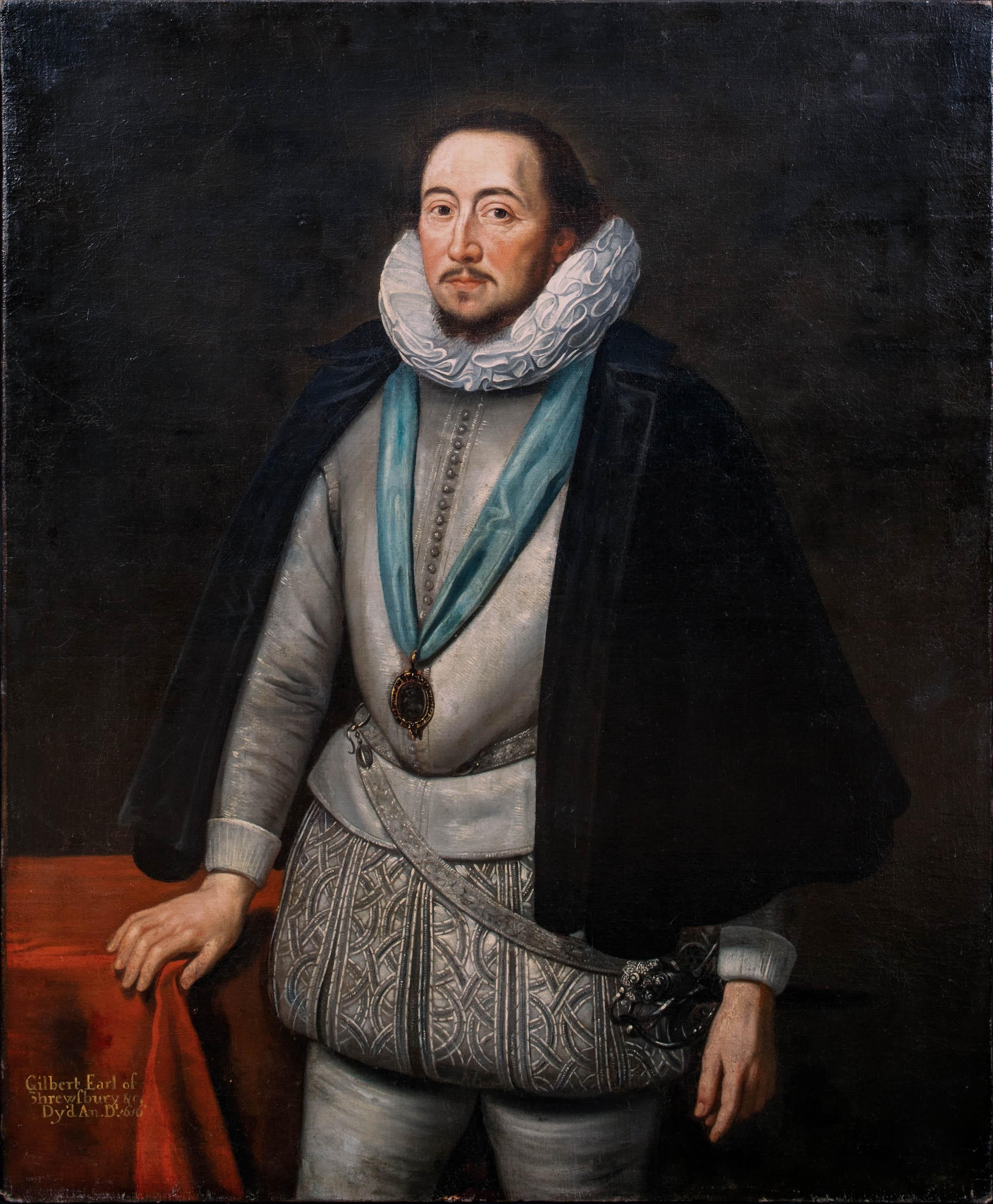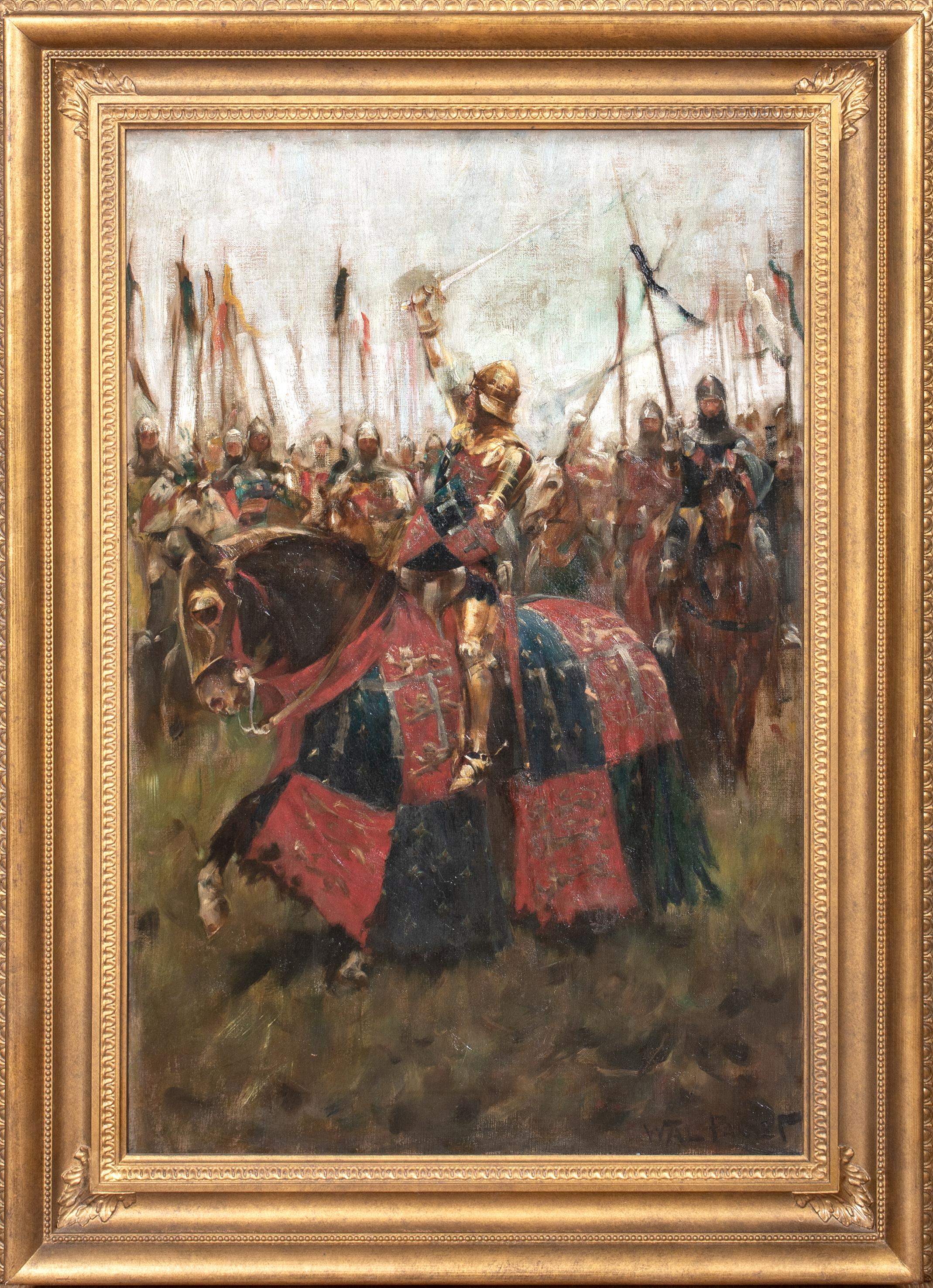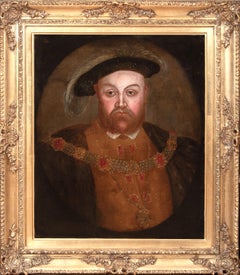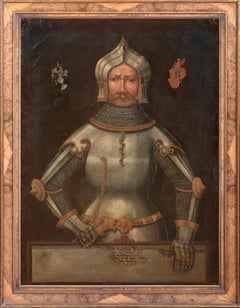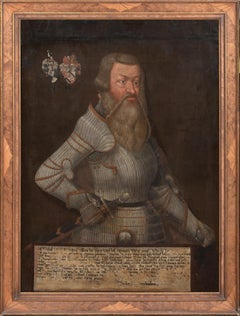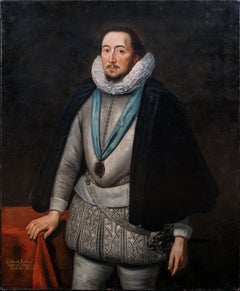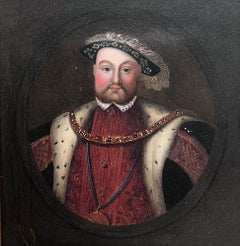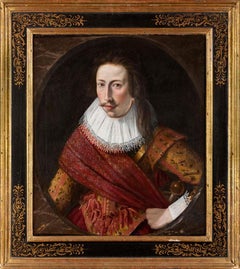Items Similar to Portrait of Henry IV, King of England (1367-1413), 16th Century
Want more images or videos?
Request additional images or videos from the seller
1 of 14
UnknownPortrait of Henry IV, King of England (1367-1413), 16th Century
$14,269.78
$17,837.2320% Off
£10,400
£13,00020% Off
€12,170.98
€15,213.7320% Off
CA$19,906.03
CA$24,882.5420% Off
A$21,593.55
A$26,991.9420% Off
CHF 11,355.09
CHF 14,193.8720% Off
MX$262,749.85
MX$328,437.3120% Off
NOK 141,956.98
NOK 177,446.2220% Off
SEK 133,882.86
SEK 167,353.5820% Off
DKK 90,871.98
DKK 113,589.9720% Off
About the Item
Portrait of Henry IV, King of England (1367-1413), 16th Century
English School Portrait - Early Oil On Panel
Large 16th Century court portrait of Henry IV, King Of England (1367-1413), oil on panel. Excellent quality and condition for its age depicting Henry IV holding the sceptre and the rose and emblem of the House of Lancaster. Presented in and ebony and gilt frame.
Provenance: Private UK Collection
Measurements: 24.5" x 20.5" framed approx
- Dimensions:Height: 24.5 in (62.23 cm)Width: 20.5 in (52.07 cm)
- Medium:
- Period:
- Condition:
- Gallery Location:Blackwater, GB
- Reference Number:1stDibs: LU1577214488222
About the Seller
4.9
Vetted Professional Seller
Every seller passes strict standards for authenticity and reliability
Established in 2008
1stDibs seller since 2021
298 sales on 1stDibs
Typical response time: 1 hour
- ShippingRetrieving quote...Shipping from: Blackwater, United Kingdom
- Return Policy
Authenticity Guarantee
In the unlikely event there’s an issue with an item’s authenticity, contact us within 1 year for a full refund. DetailsMoney-Back Guarantee
If your item is not as described, is damaged in transit, or does not arrive, contact us within 7 days for a full refund. Details24-Hour Cancellation
You have a 24-hour grace period in which to reconsider your purchase, with no questions asked.Vetted Professional Sellers
Our world-class sellers must adhere to strict standards for service and quality, maintaining the integrity of our listings.Price-Match Guarantee
If you find that a seller listed the same item for a lower price elsewhere, we’ll match it.Trusted Global Delivery
Our best-in-class carrier network provides specialized shipping options worldwide, including custom delivery.More From This Seller
View AllPortrait Of King Henry VIII (1491-1547), 17th Century Royal Court Portrait
Located in Blackwater, GB
Portrait Of King Henry VIII (1491-1547), 17th Century
English School Royal Court Portrait
Large 17th Century English Royal Court Portrait of King Henry VIII Of England, oil on canv...
Category
17th Century Portrait Paintings
Materials
Canvas, Oil
$6,037 Sale Price
20% Off
Portrait Of Eitel Friedrich II, Count of Hohenzollern (1452-1512), 16th Century
Located in Blackwater, GB
Portrait Of Eitel Friedrich II, Count of Hohenzollern (1452-1512), 16th Century
German School Court Portrait
Large 16th Century German Old Master portrait identified as Eitel Frede...
Category
16th Century Portrait Paintings
Materials
Canvas, Oil
$8,232 Sale Price
20% Off
Portrait Of Eitel Friedrich II, Count of Hohenzollern (1452-1512), 16th Century
Located in Blackwater, GB
Portrait Of Frederick I, Elector Of Brandenburg Knight Of Hohenzollern 1420, 16th Century
German School Court Portrait
Large 16th Century German Old Master portrait identified as F...
Category
16th Century Portrait Paintings
Materials
Canvas, Oil
$8,232 Sale Price
20% Off
Portrait Of Gilbert Talbot 7th Earl of Shrewsbury (1552-1616), 16th Century
Located in Blackwater, GB
Portrait Of Gilbert Talbot 7th Earl of Shrewsbury (1552-1616), 16th Century
Circle of George Gower (c.1540–1596)
Huge 16th Century Portrait Of Gil...
Category
18th Century Portrait Paintings
Materials
Canvas, Oil
$16,465 Sale Price
20% Off
King Henry V Of England, The Battle Of Agincourt 1415, 19th Century
Located in Blackwater, GB
King Henry V Of England, The Battle Of Agincourt 1415, 19th Century
by WALTER STANLEY PAGET (1861-1908)
Large 19th Century scene of King Henry V at the Battle Of Agincourt 1415, oi...
Category
19th Century Portrait Paintings
Materials
Canvas, Oil
$5,049 Sale Price
20% Off
Portrait Of King Edward VI (1537-1553) as Prince Of Wales, 16th Century
Located in Blackwater, GB
Portrait Of King Edward VI (1537-1553) as Prince Of Wales, 16th Century
English School - Oil on panel - circa 1547
Large 16th Century portrait of Edward VI as Prince Of Wales, oil on panel. Early and important portrait...
Category
16th Century Portrait Paintings
Materials
Oil, Wood Panel
$10,866 Sale Price
20% Off
You May Also Like
Portrait of William Herbert, 3rd Earl of Pembroke, Early 17th Century Portrait
Located in London, GB
English School, (circa 1600)
Portrait of William Herbert, 3rd Earl of Pembroke
Oil on panel, oval
Image size: 29¼ x 23⅞ inches
Painted wooden frame
Provenance:
176, Collection of Francis Greville, 1st Earl of Warwick.
The Trustees of the Lord Brooks’ Settlement, (removed from Warwick Castle).
Sotheby’s, London, 22nd March 1968, lot 81.
Painted onto wooden panel, this portrait shows a dark haired gentleman in profile sporting an open white shirt. On top of this garments is a richly detailed black cloak, decorated with gold thread and lined with a sumptuous crimson lining. With the red silk inside it’s all very expensive and would fall under sumptuary laws – so this is a nobleman of high degree.
It’s melancholic air conforms to the contemporary popularity of this very human condition, evident in fashionable poetry and music of the period. In comparison to our own modern prejudices, melancholy was associated with creativity in this period.
This portrait appeared in the earliest described list of pictures of Warwick castle dating to 1762. Compiled by collector and antiquary Sir William Musgrave ‘taken from the information of Lord & Lady Warwick’ (Add. MSS, 5726 fol. 3) is described;
‘8. Earl of Essex – an original by Zuccharo – seen in profile with black hair. Holding a black robe across his breast with his right hand.’
As tempting as it is to imagine that this is a portrait of Robert Devereux, the 2nd Earl Essex, we might take this with a pinch of salt. Its identification with this romantic and fatal Elizabethan might well have been an attempt to add romance to Warwick Castle’s walls. It doesn’t correspond all that well with Essex’s portraits around 1600 after his return from Cadiz. Notably, this picture was presumably hung not too far away from the castle’s two portraits of Queen Elizabeth I. The first, and undoubtedly the best, being the exquisite coronation portrait that was sold by Lord Brooke in the late 1970s and now hangs in the National Portrait Gallery. The second, described as being ‘a copy from the original at Ld Hydes’, has yet to resurface.
The portrait eventually ended up being hung in the State Bedroom of Warwick Castle.
Archival documents present one other interesting candidate. The Greville family’s earliest inventory of paintings, made in 1630 at their home Brooke House in Holborn, London, describes five portraits of identified figures. All five belonged to the courtier, politician and poet Sir Fulke Greville (1554-1628), 1st Baron Brooke, and were hung in the ‘Gallerie’ of Brooke House behind yellow curtains. One of them was described as being of ‘Lord of Pembrooke’, which is likely to have been William Herbert (1580-1630), 3rd Earl of Pembroke. William was the eldest son of Greville’s best friend’s sister Mary Sidney, and was brought up in the particularly literary and poetically orientated household which his mother had supported. Notably, the 3rd Earl was one of the figures that Shakespeare’s first folio was dedicated to in 1623.
The melancholic air to the portrait corresponds to William’s own pretensions as a learned and poetic figure. The richness of the robe in the painting, sporting golden thread and a spotted black fabric, is indicative of wealth beyond that of a simple poet or actor. The portrait’s dating to around the year 1600 might have coincided with William’s father death and his own rise to the Pembroke Earldom. This period of his life too was imbued with personal sadness, as an illicit affair with a Mary Fitton had resulted in a pregnancy and eventual banishment by Elizabeth I to Wilton after a short spell in Fleet Prison. His illegitimate son died shortly after being born. Despite being a close follower of the Earl of Essex, William had side-stepped supporting Devereux in the fatal uprising against the Queen and eventually regained favour at the court of the next monarch James I.
His linen shirt is edged with a delicate border of lace and his black cloak is lined on the inside with sumptuous scarlet and richly decorated on the outside with gold braid and a pattern of embroidered black spots.
Despite the richness of his clothes, William Herbert has been presented in a dishevelled state of semi-undress, his shirt unlaced far down his chest with the ties lying limply over his hand, indicating that he is in a state of distracted detachment. It has been suggested that the fashion for melancholy was rooted in an increase in self-consciousness and introspective reflection during the late 16th and early 17th centuries.
In contemporary literature melancholy was said to be caused by a plenitude of the melancholy humor, one of the four vital humors, which were thought to regulate the functions of the body. An abundance of the melancholia humor was associated with a heightened creativity and intellectual ability and hence melancholy was linked to the notion of genius, as reflected in the work of the Oxford scholar Robert Burton, who in his work ‘The Anatomy of Melancholy’, described the Malcontent as ‘of all others [the]… most witty, [who] causeth many times divine ravishment, and a kind of enthusiamus… which stirreth them up to be excellent Philosophers, Poets and Prophets.’ (R. Burton, The Anatomy of Melancholy, London, 1621 in R. Strong, ‘Elizabethan Malady: Melancholy in Elizabethan and Jacobean Portraits’, Apollo, LXXIX, 1964).
Melancholy was viewed as a highly fashionable affliction under Elizabeth I, and her successor James I, and a dejected demeanour was adopted by wealthy young men, often presenting themselves as scholars or despondent lovers, as reflected in the portraiture and literature from this period. Although the sitter in this portrait is, as yet, unidentified, it seems probable that he was a nobleman with literary or artistic ambitions, following in the same vain as such famous figures as the aristocratic poet and dramatist, Edward de Vere...
Category
Early 17th Century Old Masters Portrait Paintings
Materials
Oil, Wood Panel
Portrait King Henry 8th VIII Antique English Painting Famous Monarch
Located in Cirencester, Gloucestershire
King Henry VIII
English artist, circa 1840's
oil on paper laid on board, framed
framed: 10.5 x 10inches
board: 8 x 7.5 inches
inscribed verso
provenance: private collection, UK
cond...
Category
Early 19th Century English School Portrait Paintings
Materials
Oil
$1,042 Sale Price
20% Off
Portrait Of A Scottish Monarch Oil On Canvas 19th Century
Located in Milan, IT
Oil on canvas. Intense and high quality, the painting depicts a monarch of the royal house of Scotland.
Around the portrait, in a painted oval frame, there are some writings: the name Rober(t) appears at the top left, the title Rex at the bottom left and the abbreviation Scot, which stands for Scotorum, on the right; the writing at the top right is not identifiable, but it seems to be an acronym.
The man portrayed wears a hat and a coat adorned with ermine fur, which is considered the noblest fur, reserved for royalty. He wears a golden pendant around his neck, which depicts two leaves with the fruit of the thistle, which, in heraldry, symbolizes Scotland.
The writing and the pendant therefore refer to a Robert of Scotland, probably from the dynasty that reigned in the fourteenth century.
The portrait was however executed in the romantic nineteenth-century period, probably using some ancient engravings...
Category
19th Century Other Art Style Portrait Paintings
Materials
Oil
$10,045 Sale Price
20% Off
Portrait of an Officer, Cornelius Johnson, 17th Century Old Masters
By Cornelius Johnson
Located in London, GB
Circle of Cornelius Johnson
Circa 1620’s
Portrait of a Officer
Oil on canvas
Image size: 28 x 24 inches
Period style hand made frame
Provenance
Private European Estate
This striking portrait dates to around 1620, as you can see from the images of the sash the detail is very high. The sash is decorated with gold thread and would have cost a small fortune at the time. Sashes were originally developed for a military function (making officers more visible for their men during combat), but soon became a primarily male fashion...
Category
Early 17th Century Old Masters Portrait Paintings
Materials
Oil
Portrait of Geoffrey Chaucer, Oil on Oak Panel Portrait, 16th Century
Located in London, GB
Oil on oak panel
Image size: 14 1/4 x 11 3/4 inches (36 x 30 cm)
Period style frame
This portrait shows Chaucer with a string of beads in one hand and a writing implement in the other. The Arms in the top left of the picture are the Arms of Chaucer, featuring a per pale argent and gules, a bend counterchanged.
This painting appears to derive, like all other portraits of Chaucer, from an illustration in an early fifteenth-century manuscript, Hoccleve's De Regimine Principum. Here Hoccleve included one portrait of Chaucer, showing him with an inkhorn around his neck and holding a rosary in one hand. Since it is likely that Hoccleve had met Chaucer, many scholars believe this could be the most genuine representation of the English writer with all other depictions being seemingly based on it.
In almost all portraits of Chaucer, including this one, the poet is shown wearing a pendant attached to his vest. This item is often considered to be a penner, included in the artworks as a sign of the general occupation of a writer. Whilst the pendant is generally accepted as a case for a writing instrument, possibly with equal plausibility, it has also been suggested that the item is an ampulla, a small lead vial containing water and the blood of St. Thomas Becket...
Category
16th Century Portrait Paintings
Materials
Oil, Panel
Rare Antique Portrait of James V, King of Scotland, 1615
Located in Langweer, NL
Antique portrait titled 'Iacobus V'. Portrait of James V of Scotland. This print originates from 'Tooneel der keyseren ende coningen van christenryck sedert de...
Category
Antique 17th Century Prints
Materials
Paper
$306 Sale Price
20% Off
More Ways To Browse
Henry Iv
16th Century England
16th Century Unknown Portrait
Painting Of A Salon
Portrait Of Maurice
Rembrandt Oil Painting
Antique Baby Portrait
Charlize Theron
Elizabeth Olds
Jenny Saville
Luxury Pop Art
Man In Hat Painting
Oil Paintings Marilyn Monroe
Portrait Of King George
Antique Mantilla
Gina Palmerin
Guido Reni Oil Painting
Merchant Portrait
